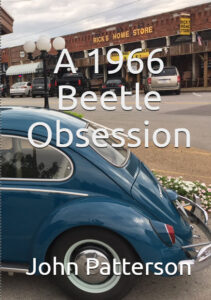Wolfsburg Germany
The Wolfsburg Volkswagenwerk

Model of the Volkswagen Factory as proposed in the 1930’s
In May of 1937 the German Government established a company to build Ferdinand Porsche’s Volkswagen. The Name of the Company was Gesellschaft zur Vorbereitung des Deutschen Volkswagens, which directly translated means “Society for the preparation of the German Volkswagen”. The German Labor Front (AKA: DAF), the only labor organization allowed in Nazi Germany, would finance this project.
The location for this company ended up in the Lower Saxony area near the village of Fallersleben. An unpopulated area at the time, the location provided access to roadways, rail, and the Mittelland canal. Much of the land belonged to only a few owners with large estates. The other buildings that occupied the land were houses grouped around existing castles and churches.
The car itself would be called the KDF-Wagen (The strength through joy car), and the surrounding town that was built to support the factory would be known as ‘KdF-Stadt’ or the Strength through Joy City. The names never really stuck and all the cars that were produced continued to be referred to as Volkswagen (Peoples Car) as well as stamped that way at the factory. In later years the city itself was named Wolfsburg after a nearby Castle.
The factory was well furnished with American machine tools and equipment sourced by Porsche during his visits to the United States in 1936 and 1937.
Meanwhile the propaganda machine was in full gear promoting the new KDF-Wagen. A program was put in place that would allow the German People to save money and buy a stamp each week (5 books of 50 stamps per book would need to be completed to receive a car) in order to buy a Volkswagen. In addition several different raffles were held in the hopes of winning one of the new cars, however no one ever received a Volkswagen through either of these programs.
The original plan was for the factory to manufacture 1.5 million vehicles within two years, however on September 1st of 1939 Germany invaded Poland – WWII had begun – and at this point not one Volkswagen had reached the German people.

The Volkswagen Power Plant under Construction and the Mittelland Canal.
During WWII few cars were produced in the factory (only 630 through 1944, and these were only distributed to high ranking Government officials) as it was converted over to producing vehicles for the war effort (including variants of the Beetle equipped with Machine guns as well as pilot-less airplanes armed with explosives for this effort). Due to this fact it became a target for air strikes by the Allies, and it was heavily damaged during six air strikes beginning on April 8th of 1944. These attacks resulted in three quarters of the factory being destroyed. The one thing that may have saved the Volkswagen from completely disappearing from the face of the planet at this point was the fact that most of the heavy presses and machinery had been moved to the basements in the factory or several outbuildings where they had been spared from the bombing raids.
On April 10th a division of American Infantry reached nearby Fallersleben and the factory was captured. The Country was divided into quarters, and as the KdF factory was located in the British section therefore it fell under British control.
From 1945 to 1949 the British army operated the factory under the direction of Major Ivan Hirst. Hirst was instrumental in saving the factory from being destroyed after finding a beetle in a workshop at the factory and realizing the factory could produce vehicles for the British Army. Hirst was able to persuade the British Army to order 20,000 beetles (later referred to as the Model 1), and about 1800 were produced during 1945.
In 1946, the factory was producing 1000 cars per month, and became civilian operated under the direction of the British Army.
In March 1948, the British offered the Volkswagen company to Henry Ford, free of charge. Henry Ford II, the son of Edsel Ford went to West Germany for discussions. Heinz Nordhoff was also present, as was Ernest Breech, the chairman of the board for Ford at the time. Breech relayed to Henry Ford “Mr. Ford, I don’t think what we’re being offered here is worth a damn! So, Ford passed on the offer, leaving Volkswagen to rebuild itself under Nordhoff’s leadership.
In 1949 five years after the British Army had resurrected the Wolfsburg Factory, Heinze Nordhoff became the director of the auto manufacturer. Heinze Nordhoff took the VW factory to a new level where production soared during the next decades. By 1955 one million VW beetles had been produced. It had become a highly desired and reliable means of transportation for people all over the world. The production number increased steadily through the 1960’s.
In the 1970’s, amid safety concerns and stiff competition and an engine that was small compared to most other vehicles on the market, the sales began to dramatically fall. In 1974 the Beetle was still being produced but no longer was that production at the Wolfsburg Plant. Now the factory had been converted to producing water cooled vehicles. The era of the Beetle at Wolfsburg was over.
Today the factory in Wolfsburg continues to produce Volkswagen vehicles, it is the largest automobile plant in the world
© 2005-2024 1966vwbeetle.com – All Rights Reserved
